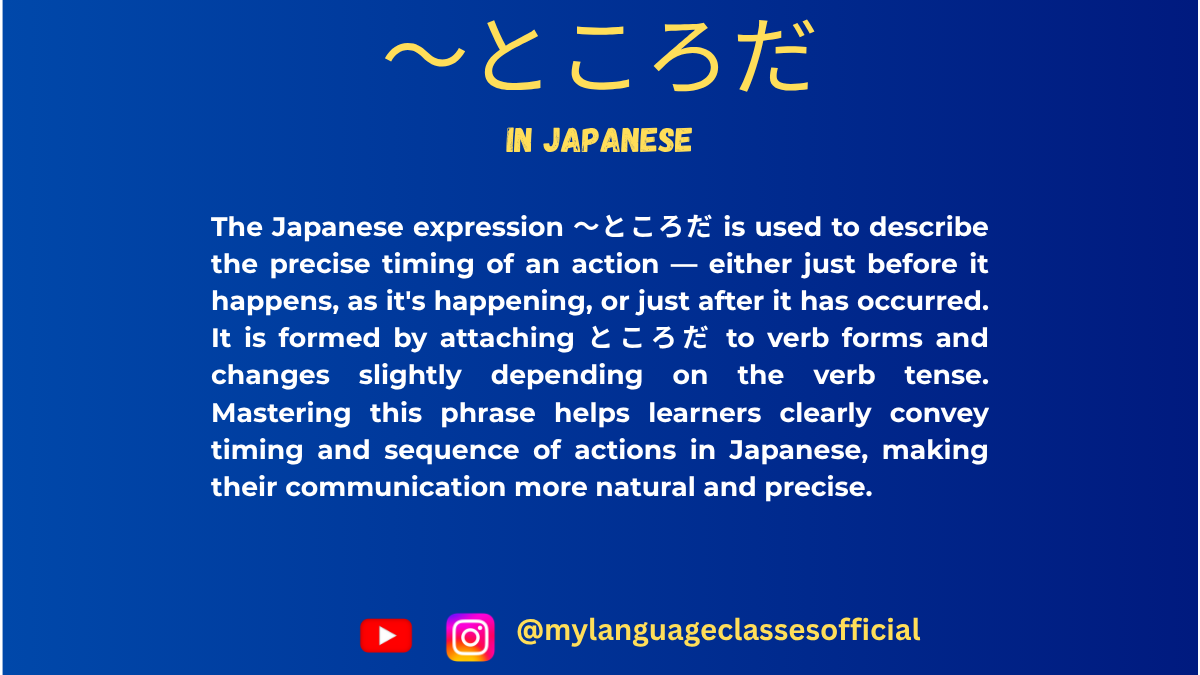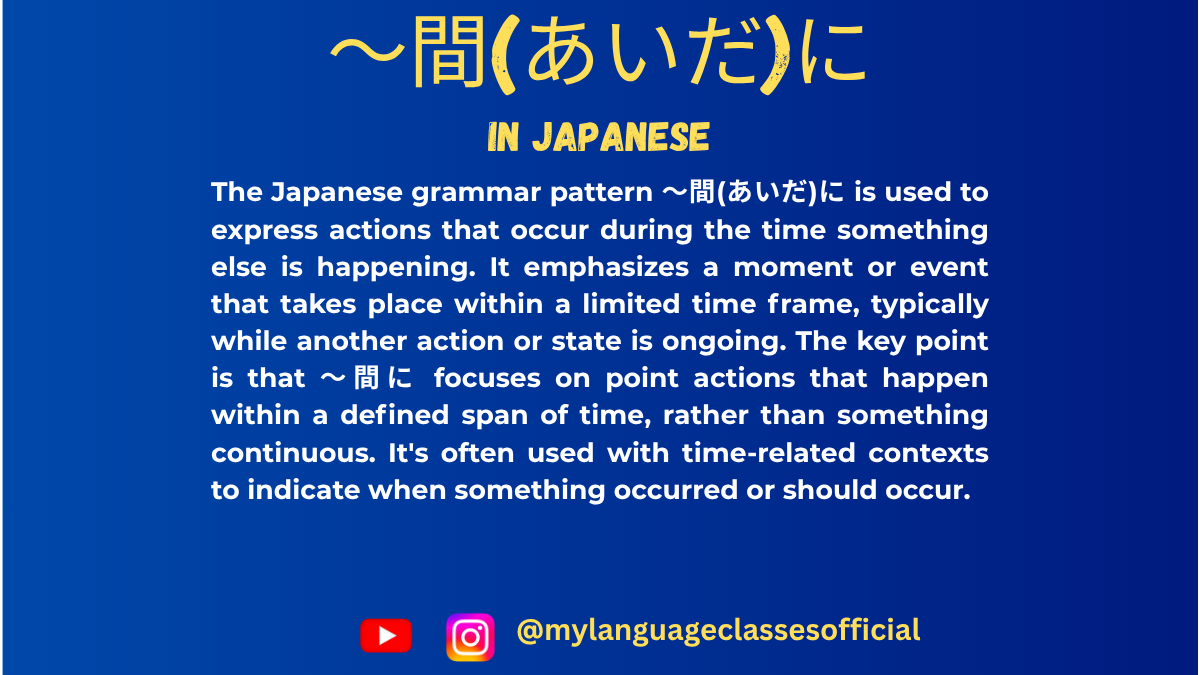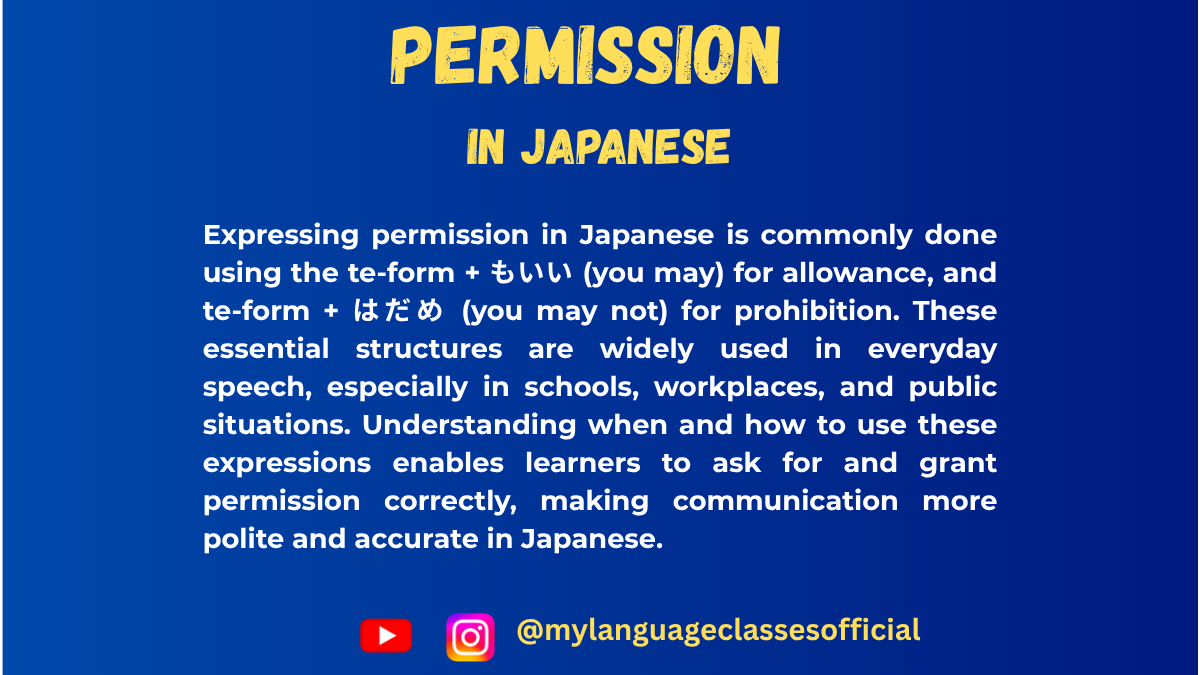Your cart is currently empty!
Tag: Learn Japanese
-

Using 〜とおり in Japanese | My Language Classes
Understanding「〜とおり」 in Japanese
If you’re learning Japanese, you’ve probably come across the phrase 「〜とおり」 at some point. This grammar pattern is incredibly useful for expressing actions, instructions, and events happening “as expected,” “just as,” or “in the same way” as something else. Whether you’re following a recipe, describing an event, or giving precise instructions, 「〜とおり」 helps you communicate with accuracy and clarity.
In this comprehensive guide, you’ll learn:
✅ The true meaning of 「〜とおり」 and why it’s so powerful
✅ How to use 「〜とおり」 correctly in everyday conversations
✅ Common mistakes learners make (and how to avoid them!)
✅ Real-life example sentences with Romaji, and English translationsBy the end of this lesson, you’ll not only understand 「〜とおり」 perfectly, but you’ll also be able to use it naturally, just like a native speaker.
Let’s dive in!
Common Expressions Using 「〜とおり」
Now that you understand the basics of 「〜とおり」, let’s explore 10 useful expressions where this grammar pattern naturally appears. These phrases are commonly used in daily conversations, instructions, and even formal speech.
1. 思ったとおり (Omotta tōri) – Just as I thought
📌 Example:
🔹 思ったとおり、テストは難しかった。
🔹 Omotta tōri, tesuto wa muzukashikatta.
🔹 (Just as I thought, the test was difficult.)2. 予想どおり (Yosō dōri) – As expected
📌 Example:
🔹 予想どおり、雨が降り始めた。
🔹 Yosō dōri, ame ga furi hajimeta.
🔹 (As expected, it started to rain.)3. 指示どおり (Shiji dōri) – According to instructions
📌 Example:
🔹 先生の指示どおりに、宿題をしました。
🔹 Sensei no shiji dōri ni, shukudai o shimashita.
🔹 (I did my homework according to the teacher’s instructions.)4. 予定どおり (Yotei dōri) – As planned
📌 Example:
🔹 旅行は予定どおりに進んでいます。
🔹 Ryokō wa yotei dōri ni susundeimasu.
🔹 (The trip is going as planned.)5. ルールどおり (Rūru dōri) – According to the rules
📌 Example:
🔹 試合はルールどおりに行われました。
🔹 Shiai wa rūru dōri ni okonawaremashita.
🔹 (The match was conducted according to the rules.)6. 予報どおり (Yohō dōri) – Just like the forecast said
📌 Example:
🔹 天気は予報どおりに晴れた。
🔹 Tenki wa yohō dōri ni hareta.
🔹 (The weather cleared up just like the forecast said.)7. 計画どおり (Keikaku dōri) – As per the plan
📌 Example:
🔹 プロジェクトは計画どおりに進んでいます。
🔹 Purojekuto wa keikaku dōri ni susundeimasu.
🔹 (The project is progressing as per the plan.)8. 約束どおり (Yakusoku dōri) – As promised
📌 Example:
🔹 約束どおり、明日会いましょう。
🔹 Yakusoku dōri, ashita aimashō.
🔹 (Let’s meet tomorrow as promised.)9. 本のとおり (Hon no tōri) – Just like the book says
📌 Example:
🔹 この料理は本のとおりに作りました。
🔹 Kono ryōri wa hon no tōri ni tsukurimashita.
🔹 (I made this dish just like the book says.)10. マニュアルのとおり (Manyuaru no tōri) – Following the manual
📌 Example:
🔹 マニュアルのとおりに設定してください。
🔹 Manyuaru no tōri ni settei shite kudasai.
🔹 (Please set it up according to the manual.)These 10 practical expressions will help you use 「〜とおり」 in real-life situations with confidence. Try practicing them in conversations and writing to make them feel natural!
Usage of 「〜とおり」
The grammar point 「〜とおり」 is highly versatile and used in various real-life situations. Below are the key scenarios where this expression is commonly applied:
1. Expressing “Just as Expected”
You can use 「〜とおり」 to show that something happened exactly as you predicted or expected.
✅ Example:
🔹 思ったとおり、試験は難しかった。
🔹 Omotta tōri, shiken wa muzukashikatta.
🔹 (Just as I thought, the exam was difficult.)
2. Following Instructions or Orders
When you need to indicate that something was done according to given instructions, rules, or commands, 「〜とおり」 is the perfect phrase to use.
✅ Example:
🔹 先生の指示どおりに宿題をやりました。
🔹 Sensei no shiji dōri ni shukudai o yarimashita.
🔹 (I did my homework according to the teacher’s instructions.)
3. Describing Plans and Predictions
If something happens as planned or as forecasted, 「〜とおり」 helps to express that the outcome matched the expectation.
✅ Example:
🔹 旅行は予定どおりに進んでいます。
🔹 Ryokō wa yotei dōri ni susundeimasu.
🔹 (The trip is going as planned.)✅ Example:
🔹 天気は予報どおりに晴れた。
🔹 Tenki wa yohō dōri ni hareta.
🔹 (The weather cleared up just like the forecast said.)
4. Performing Actions in the Same Manner
You can use 「〜とおり」 when instructing someone to follow a manual, book, or any set of instructions exactly as given.
✅ Example:
🔹 マニュアルのとおりに設定してください。
🔹 Manyuaru no tōri ni settei shite kudasai.
🔹 (Please set it up according to the manual.)✅ Example:
🔹 本のとおりに料理を作りました。
🔹 Hon no tōri ni ryōri o tsukurimashita.
🔹 (I made the dish exactly as written in the book.)
5. Describing Rules and Regulations
When something follows a set of rules, laws, or official guidelines, 「〜とおり」 can be used to describe adherence to them.
✅ Example:
🔹 試合はルールどおりに行われました。
🔹 Shiai wa rūru dōri ni okonawaremashita.
🔹 (The match was conducted according to the rules.)
6. Keeping Promises
When you want to emphasize that something was done as promised, you can use 「〜とおり」 to confirm that the commitment was fulfilled.
✅ Example:
🔹 約束どおりにお金を返しました。
🔹 Yakusoku dōri ni okane o kaeshimashita.
🔹 (I returned the money as promised.)
7. Explaining Results Matching Expectations
When an outcome perfectly matches an expectation or prediction, 「〜とおり」 expresses that sense of alignment.
✅ Example:
🔹 予想どおり、彼が試合に勝った。
🔹 Yosō dōri, kare ga shiai ni katta.
🔹 (As expected, he won the match.)
8. Giving Step-by-Step Instructions
If you need to explain how to do something in a step-by-step manner, you can use 「〜とおり」 to ensure that actions are followed precisely.
✅ Example:
🔹 私の言うとおりにしてください。
🔹 Watashi no iu tōri ni shite kudasai.
🔹 (Please do exactly as I say.)These are the most common situations where 「〜とおり」 is used in Japanese. This grammar point is essential for daily communication, making instructions clear, and expressing expectations accurately.
Conjugation of 「〜とおり」 with Verb
The grammar point 「〜とおり」 can be used with verbs in different forms. Below is a complete breakdown of how to use it with:
- Dictionary Form (Plain Form) → (Verb as is)
- Past Form (Ta-form) → (Verb in た-form)
- Stem Form (Masu-stem for ます verbs) → (Verb without ます)
1. Conjugation of 「〜とおり」 with Different Verb Groups
Verb Group Dictionary Form (Plain Form) + とおり Past Form (Ta-form) + とおり Stem Form (Masu-stem) + とおり Group 1 (う-Verbs) 読むとおり (Yomu tōri) → (As one reads…) 読んだとおり (Yonda tōri) → (As one read…) 読みとおり (Yomi tōri) → (As one is reading…) Group 2 (る-Verbs) 見るとおり (Miru tōri) → (As one sees…) 見たとおり (Mita tōri) → (As one saw…) 見とおり (Mi tōri) → (As one is seeing…) Group 3 (Irregular Verbs) する通り (Suru tōri) → (As one does…) 来るとおり (Kuru tōri) → (As one comes…) したとおり (Shita tōri) → (As one did…) 来たとおり (Kita tōri) → (As one came…) しとおり (Shi tōri) → (As one is doing…) 来とおり (Ki tōri) → (As one is coming…)
2. Example Sentences for Each Verb Group in Different Forms
📌 Group 1 (う-Verbs) Example: 「書く」 (kaku – to write)
✅ Dictionary Form:
🔹 先生が書くとおりにメモしてください。
🔹 Sensei ga kaku tōri ni memo shite kudasai.
🔹 (Please take notes exactly as the teacher writes.)✅ Past Form (Ta-form):
🔹 先生が書いたとおりに答えを書いてください。
🔹 Sensei ga kaita tōri ni kotae o kaite kudasai.
🔹 (Please write the answer exactly as the teacher wrote.)✅ Stem Form (Masu-stem):
🔹 先生の書きとおりに書けば大丈夫です。
🔹 Sensei no kaki tōri ni kakeba daijōbu desu.
🔹 (If you write as the teacher is writing, you’ll be fine.)
📌 Group 2 (る-Verbs) Example: 「食べる」 (taberu – to eat)
✅ Dictionary Form:
🔹 レシピに書いてあるとおりに食べると美味しいです。
🔹 Reshipi ni kaite aru tōri ni taberu to oishii desu.
🔹 (It’s delicious if you eat it as written in the recipe.)✅ Past Form (Ta-form):
🔹 レシピのとおりに食べたら、美味しかった。
🔹 Reshipi no tōri ni tabetara, oishikatta.
🔹 (It was delicious when I ate it as per the recipe.)✅ Stem Form (Masu-stem):
🔹 レシピの食べとおりに作れば大丈夫です。
🔹 Reshipi no tabe tōri ni tsukureba daijōbu desu.
🔹 (If you cook it as you are eating, it will be fine.)
📌 Group 3 (Irregular Verbs) Example: 「する」 (suru – to do) & 「来る」 (kuru – to come)
✅ Dictionary Form:
🔹 彼がする通りにやってください。
🔹 Kare ga suru tōri ni yatte kudasai.
🔹 (Please do it just as he does.)✅ Past Form (Ta-form):
🔹 彼がしたとおりにやれば成功します。
🔹 Kare ga shita tōri ni yareba seikō shimasu.
🔹 (If you do it as he did, you will succeed.)✅ Stem Form (Masu-stem):
🔹 彼のしとおりに練習すれば上手になります。
🔹 Kare no shi tōri ni renshū sureba jōzu ni narimasu.
🔹 (If you practice as he is doing, you will improve.)
📌 Example with 「来る」 (Kuru – to come)
✅ Dictionary Form:
🔹 先生が来るとおりに準備してください。
🔹 Sensei ga kuru tōri ni junbi shite kudasai.
🔹 (Prepare as the teacher comes.)✅ Past Form (Ta-form):
🔹 先生が来たとおりに、試験が始まります。
🔹 Sensei ga kita tōri ni, shiken ga hajimarimasu.
🔹 (As the teacher arrived, the exam started.)✅ Stem Form (Masu-stem):
🔹 先生の来とおりに行動してください。
🔹 Sensei no ki tōri ni kōdō shite kudasai.
🔹 (Act as the teacher is coming.)By mastering the different verb conjugations with 「〜とおり」, you can express actions that are done exactly as expected, predicted, or instructed. Whether you are following a manual, repeating someone’s actions, or verifying if something happened as anticipated, this grammar pattern is essential for clear and natural Japanese communication!
Conjugation of 「〜とおり」 with Nouns and Adjectives
In addition to verbs, 「〜とおり」 can also be used with nouns and adjectives to express “as expected,” “just like,” or “exactly as.” Below is a detailed breakdown of how to use 「〜とおり」 with:
- Nouns
- い-Adjectives
- な-Adjectives
1. Conjugation of 「〜とおり」 with Nouns
📌 Rule for Nouns:
For nouns, 「の」 is added before 「とおり」 to link the two words.
🔹 Noun + の + とおり → (As per [Noun], Just like [Noun])Noun Example Sentence Romaji English Translation 予想 (yosou) – Expectation 予想のとおり、試験は難しかった。 Yosou no tōri, shiken wa muzukashikatta. As expected, the exam was difficult. 説明 (setsumei) – Explanation 先生の説明のとおりにやってください。 Sensei no setsumei no tōri ni yatte kudasai. Please do it exactly as explained by the teacher. 計画 (keikaku) – Plan 計画のとおりに進めます。 Keikaku no tōri ni susumemasu. We will proceed according to the plan. 指示 (shiji) – Instructions 指示のとおりに行動してください。 Shiji no tōri ni kōdō shite kudasai. Please act as per the instructions. 地図 (chizu) – Map 地図のとおりに行けば、迷いません。 Chizu no tōri ni ikeba, mayoimasen. If you follow the map, you won’t get lost.
2. Conjugation of 「〜とおり」 with い-Adjectives
📌 Rule for い-Adjectives:
Since い-adjectives cannot directly attach to 「とおり」, they are converted into their noun form by adding 「こと」 before 「とおり」.
🔹 い-Adjective + こと + とおり → (As [Adjective] as expected)い-Adjective Example Sentence Romaji English Translation 簡単 (kantan) – Simple 思ったこととおり、問題は簡単だった。 Omotta koto tōri, mondai wa kantan datta. As I thought, the problem was simple. 難しい (muzukashii) – Difficult 聞いたこととおり、その試験は難しい。 Kiita koto tōri, sono shiken wa muzukashii. As I heard, that exam is difficult. 楽しい (tanoshii) – Fun 予想したこととおり、旅行はとても楽しかった。 Yosou shita koto tōri, ryokō wa totemo tanoshikatta. As I expected, the trip was really fun. 正しい (tadashii) – Correct あなたの言ったこととおり、それは正しかった。 Anata no itta koto tōri, sore wa tadashikatta. As you said, that was correct. 高い (takai) – Expensive 店員が言ったこととおり、その時計は高かった。 Ten’in ga itta koto tōri, sono tokei wa takakatta. As the clerk said, that watch was expensive.
3. Conjugation of 「〜とおり」 with な-Adjectives
📌 Rule for な-Adjectives:
Since な-adjectives function like nouns, they follow the same rule as nouns and use 「の」 before 「とおり」.
🔹 な-Adjective + な + の + とおり → (As [Adjective] as expected)な-Adjective Example Sentence Romaji English Translation 静か (shizuka) – Quiet 彼の部屋は聞いたのとおり、静かだった。 Kare no heya wa kiita no tōri, shizuka datta. As I heard, his room was quiet. 有名 (yuumei) – Famous 彼女は写真のとおり、有名な人です。 Kanojo wa shashin no tōri, yūmei na hito desu. As in the photo, she is a famous person. 便利 (benri) – Convenient このアプリは説明のとおり、便利ですね。 Kono apuri wa setsumei no tōri, benri desu ne. As described, this app is convenient. 元気 (genki) – Energetic あなたの言ったのとおり、彼は元気だった。 Anata no itta no tōri, kare wa genki datta. As you said, he was energetic. 親切 (shinsetsu) – Kind その人は紹介のとおり、とても親切だった。 Sono hito wa shōkai no tōri, totemo shinsetsu datta. As introduced, that person was very kind. By learning how to use 「〜とおり」 with nouns, い-adjectives, and な-adjectives, you can express confirmation, expectations, and precise descriptions in various situations.
Got it! Here’s the Grammar Rules section with the “How to Use 「〜とおり」 with Different Word Types” part removed.
Grammar Rules of 「〜とおり」
The 「〜とおり」 grammar structure is used to express that something happens exactly as expected, planned, instructed, or perceived. Below are all the essential grammar rules related to 「〜とおり」, along with clear explanations and examples.
1️⃣ Basic Sentence Structure
「〜とおり」 is commonly used in the following pattern:
🔹 [Action/Noun] + とおり (に) + [Main Clause]
(Do something exactly as [Action/Noun] describes.)Examples:
✅ 予想のとおり、試験は難しかった。
(Yosou no tōri, shiken wa muzukashikatta.)
➡️ As expected, the exam was difficult.✅ 先生が言ったとおりに、宿題をしました。
(Sensei ga itta tōri ni, shukudai o shimashita.)
➡️ I did my homework exactly as the teacher said.
2️⃣ 「〜とおり」 vs. 「〜のとおり」
The choice between 「〜とおり」 and 「〜のとおり」 depends on the word before it.
Word Before 「とおり」 Grammar Rule Verbs Use dictionary form (plain form) or past form (た-form) before 「とおり」. Nouns Attach 「の」 before 「とおり」. Examples:
✅ 計画のとおりに進めます。
(Keikaku no tōri ni susumemasu.)
➡️ We will proceed according to the plan. (Noun + のとおり)✅ 聞いたとおりにやってください。
(Kiita tōri ni yatte kudasai.)
➡️ Please do it as you heard. (Verb in past form + とおり)
3️⃣ Optional Use of 「に」 after 「とおり」
Sometimes, 「に」 is added after 「とおり」, depending on the sentence structure.
Form Example Sentence Romaji Translation Without に 予想のとおり、彼は合格した。 Yosou no tōri, kare wa goukaku shita. As expected, he passed. With に 先生が言ったとおりにやりました。 Sensei ga itta tōri ni yarimashita. I did it exactly as the teacher said. ✅ 「に」 is optional if the meaning is still clear without it.
✅ 「に」 is required when followed by a verb, such as やる (do), 行く (go), 書く (write), 話す (speak).
4️⃣ 「〜とおり」 vs. Similar Expressions
Grammar Point Meaning Example Sentence Translation 〜とおり “As expected / As instructed” 先生が言ったとおりにやってください。 Do it as the teacher said. 〜ように “So that / In order to” 風邪を引かないように、マスクをしてください。 Wear a mask so that you don’t catch a cold. 〜まま “As is / Leave as is” 電気をつけたまま寝てしまった。 I fell asleep with the lights on. ✅ 「〜とおり」 focuses on following instructions, plans, or expectations.
✅ 「〜ように」 focuses on purpose or results.
✅ 「〜まま」 describes unchanged states.
Things to Keep in Mind When Using 「〜とおり」
Understanding 「〜とおり」 is straightforward, but there are a few tricky points and exceptions to be aware of. Below are some important rules, nuances, and mistakes to avoid when using this grammar structure.
1️⃣ Be Careful with 「に」 After 「とおり」
- The particle 「に」 is sometimes added after 「とおり」, but not always.
- 「に」 is required when a verb follows 「とおり」.
- 「に」 is optional when there is no verb immediately after 「とおり」.
Examples:
✅ 先生が言ったとおりにやってください。
(Sensei ga itta tōri ni yatte kudasai.)
➡️ Do it exactly as the teacher said. (Verb follows → に is necessary)✅ 予想のとおり、彼は合格した。
(Yosou no tōri, kare wa goukaku shita.)
➡️ As expected, he passed. (No verb immediately after → に is not used)
2️⃣ 「〜とおり」 Changes to 「〜どおり」 in Some Cases
- When attached to certain nouns, 「とおり」 becomes 「どおり」 instead.
- This happens mainly with common set expressions.
Examples:
✅ 予定どおりに試験が終わった。
(Yotei dōri ni shiken ga owatta.)
➡️ The exam ended as scheduled. (Instead of 予定のとおり, we use 予定どおり.)✅ 指示どおりに動いてください。
(Shiji dōri ni ugoite kudasai.)
➡️ Move according to the instructions.🔹 Common nouns that use 「どおり」 instead of 「とおり」:
- 予定どおり (As scheduled)
- 指示どおり (As instructed)
- 思ったどおり (As I thought)
- 希望どおり (As hoped)
💡 Tip: If a noun directly follows 「とおり」, check if it has a common どおり form!
3️⃣ Difference Between 「〜とおり」 and 「〜まま」
🔹 「〜とおり」 → Focuses on following instructions or expectations.
🔹 「〜まま」 → Focuses on keeping something unchanged.Examples:
✅ 先生が言ったとおりにやりました。
(Sensei ga itta tōri ni yarimashita.)
➡️ I did it exactly as the teacher said. (Followed the instructions)✅ 電気をつけたまま寝てしまった。
(Denki o tsuketa mama nete shimatta.)
➡️ I fell asleep with the lights on. (State remained unchanged)💡 Tip: If you’re following a plan or instructions, use 「とおり」.
If you’re keeping a condition unchanged, use 「まま」 instead.
4️⃣ Be Careful with Negative Forms
- When using 「〜とおり」 in negative sentences, be careful with meaning.
- If the first clause is negative, the second clause also follows the negative meaning.
Examples:
✅ 思ったとおり、彼は来なかった。
(Omotta tōri, kare wa konakatta.)
➡️ Just as I thought, he didn’t come.✅ 聞いたとおりにしなかったので、失敗しました。
(Kiita tōri ni shinakatta node, shippai shimashita.)
➡️ I failed because I didn’t do it as I was told.💡 Tip: If using 「〜とおり」 in a negative sentence, make sure the meaning is logical!
5️⃣ Difference Between 「〜ように」 and 「〜とおり」
Grammar Meaning Example Translation 〜とおり As expected / instructed 先生が言ったとおりに書いてください。 Write as the teacher said. 〜ように So that / In order to 風邪を引かないようにマスクをしてください。 Wear a mask so that you don’t catch a cold. 💡 Tip: If you’re talking about following instructions → Use 「〜とおり」.
If you’re talking about purpose or goals → Use 「〜ように」 instead.
6️⃣ Watch Out for Particle Changes When Using 「〜のとおり」
- When a noun comes before 「〜とおり」, use 「の」.
- When a verb comes before 「〜とおり」, do not use 「の」.
Examples:
✅ 先生の指示のとおりにやってください。
(Sensei no shiji no tōri ni yatte kudasai.)
➡️ Do it according to the teacher’s instructions. (Noun → Use の)✅ 先生が言ったとおりにやってください。
(Sensei ga itta tōri ni yatte kudasai.)
➡️ Do it exactly as the teacher said. (Verb → No の)💡 Tip: If the phrase before 「とおり」 is a noun, always use 「の」!
7️⃣ 「〜とおりにする」 vs. 「〜とおりになる」
- 「〜とおりにする」 → You actively do something as planned.
- 「〜とおりになる」 → Something naturally happens as expected.
Examples:
✅ 先生が言ったとおりにしました。
(Sensei ga itta tōri ni shimashita.)
➡️ I did exactly as the teacher said. (You actively followed instructions)✅ 予想のとおりになった。
(Yosou no tōri ni natta.)
➡️ It turned out just as expected. (Happened naturally)💡 Tip: If you’re taking action, use 「する」.
If something happens naturally, use 「なる」.
Example Sentences
Here are some example sentences using 「〜とおり」to help you understand its real-life usage.
Following Instructions or Expectations
- 先生が言ったとおりに宿題をしました。
(Sensei ga itta tōri ni shukudai o shimashita.)
➡️ I did my homework exactly as the teacher said. - レシピのとおりに料理を作りました。
(Reshipi no tōri ni ryōri o tsukurimashita.)
➡️ I cooked according to the recipe. - 説明書のとおりにパソコンを設定しました。
(Setsumeisho no tōri ni pasokon o settei shimashita.)
➡️ I set up the computer according to the manual. - 先生の指示のとおりに動いてください。
(Sensei no shiji no tōri ni ugoite kudasai.)
➡️ Please move according to the teacher’s instructions. - 私が言ったとおりにやれば、大丈夫です。
(Watashi ga itta tōri ni yareba, daijōbu desu.)
➡️ If you do it as I said, it will be fine.
Describing Things That Happened as Expected
- 予想のとおり、試験は難しかった。
(Yosou no tōri, shiken wa muzukashikatta.)
➡️ As expected, the exam was difficult. - 思ったとおりの結果でした。
(Omotta tōri no kekka deshita.)
➡️ The result was just as I thought. - 天気予報のとおりに雨が降りました。
(Tenki yohō no tōri ni ame ga furimashita.)
➡️ It rained just as the weather forecast predicted. - 彼は私が考えたとおりの人でした。
(Kare wa watashi ga kangaeta tōri no hito deshita.)
➡️ He was exactly the kind of person I thought he would be. - 噂のとおり、そのレストランの料理は美味しかった。
(Uwasa no tōri, sono resutoran no ryōri wa oishikatta.)
➡️ As the rumors said, the food at that restaurant was delicious.
Following Movements, Plans, or Changes
- 地図のとおりに進んでください。
(Chizu no tōri ni susunde kudasai.)
➡️ Please follow the map to proceed. - スケジュールのとおりに会議を進めます。
(Sukejūru no tōri ni kaigi o susumemasu.)
➡️ We will proceed with the meeting according to the schedule. - 計画どおりに仕事が進んでいます。
(Keikaku dōri ni shigoto ga susunde imasu.)
➡️ The work is progressing as planned. - マニュアルのとおりにソフトをインストールしてください。
(Manyuaru no tōri ni sofuto o insutōru shite kudasai.)
➡️ Please install the software according to the manual. - 道のとおりに歩けば、駅に着きます。
(Michi no tōri ni arukeba, eki ni tsukimasu.)
➡️ If you walk along the road, you will reach the station.
Expressing Personal Thoughts and Opinions
- あなたが言ったとおり、日本の夏はとても暑いですね。
(Anata ga itta tōri, Nihon no natsu wa totemo atsui desu ne.)
➡️ As you said, summers in Japan are very hot. - 映画は期待したとおりに面白かったです。
(Eiga wa kitai shita tōri ni omoshirokatta desu.)
➡️ The movie was as interesting as I expected. - 彼の話は聞いたとおりに正しかった。
(Kare no hanashi wa kiita tōri ni tadashikatta.)
➡️ His story was correct just as I had heard. - 彼女の料理は評判のとおりに美味しかった。
(Kanojo no ryōri wa hyōban no tōri ni oishikatta.)
➡️ Her cooking was as delicious as the reviews said. - 私が想像したとおりの素晴らしい景色でした。
(Watashi ga sōzō shita tōri no subarashii keshiki deshita.)
➡️ It was a magnificent view, just as I had imagined.
These example sentences cover different contexts where 「〜とおり」 is used. Let me know in comment if you want more examples! 😊
Exercise: Fill in the Blanks
Complete the following sentences using 「〜とおり」 appropriately. The verb, noun, or adjective that needs to be conjugated is given in parentheses (bold).
- 先生が ______ に答えてください。(言う)
- ______ に料理を作りました。(レシピ)
- ______ にパソコンを設定しました。(説明書)
- 試験は ______ 、難しかった。(予想する)
- 雨が ______ に降りました。(天気予報)
- ______ に進んでください。(地図)
- 先生の指示の ______ に動いてください。(とおり)
- 彼女の料理は ______ に美味しかった。(評判)
- 彼は私が ______ の人でした。(考える)
- あなたが ______ 、彼は本当に親切な人ですね。(言う)
- ______ に仕事が進んでいます。(計画)
- ______ に歩けば、駅に着きます。(道)
- 私が ______ の結果でした。(思う)
- 私が ______ の素晴らしい景色でした。(想像する)
- 彼の話は ______ に正しかった。(聞く)
- ______ にソフトをインストールしてください。(マニュアル)
- ______ に会議を進めます。(スケジュール)
- 先生が ______ にやれば、大丈夫です。(言う)
- 映画は ______ に面白かったです。(期待する)
- ______ 、そのレストランの料理は美味しかった。(噂)
Answers
Here are the correct answers along with Romaji and English translations.
- 先生が 言ったとおり に答えてください。
(Sensei ga itta tōri ni kotaete kudasai.)
➡️ Please answer as the teacher said. - レシピのとおり に料理を作りました。
(Reshipi no tōri ni ryōri o tsukurimashita.)
➡️ I cooked according to the recipe. - 説明書のとおり にパソコンを設定しました。
(Setsumeisho no tōri ni pasokon o settei shimashita.)
➡️ I set up the computer according to the manual. - 試験は 予想したとおり 、難しかった。
(Shiken wa yosou shita tōri, muzukashikatta.)
➡️ The exam was as difficult as predicted. - 雨が 天気予報のとおり に降りました。
(Ame ga tenki yohō no tōri ni furimashita.)
➡️ It rained just as the weather forecast predicted. - 地図のとおり に進んでください。
(Chizu no tōri ni susunde kudasai.)
➡️ Please follow the map to proceed. - 先生の指示の とおり に動いてください。
(Sensei no shiji no tōri ni ugoite kudasai.)
➡️ Please move according to the teacher’s instructions. - 彼女の料理は 評判のとおり に美味しかった。
(Kanojo no ryōri wa hyōban no tōri ni oishikatta.)
➡️ Her cooking was as delicious as the reviews said. - 彼は私が 考えたとおり の人でした。
(Kare wa watashi ga kangaeta tōri no hito deshita.)
➡️ He was exactly the kind of person I thought he would be. - あなたが 言ったとおり 、彼は本当に親切な人ですね。
(Anata ga itta tōri, kare wa hontō ni shinsetsu na hito desu ne.)
➡️ As you said, he is really a kind person. - 計画どおり に仕事が進んでいます。
(Keikaku dōri ni shigoto ga susunde imasu.)
➡️ The work is progressing as planned. - 道のとおり に歩けば、駅に着きます。
(Michi no tōri ni arukeba, eki ni tsukimasu.)
➡️ If you walk along the road, you will reach the station. - 私が 思ったとおり の結果でした。
(Watashi ga omotta tōri no kekka deshita.)
➡️ The result was just as I thought. - 私が 想像したとおり の素晴らしい景色でした。
(Watashi ga sōzō shita tōri no subarashii keshiki deshita.)
➡️ It was a magnificent view, just as I had imagined. - 彼の話は 聞いたとおり に正しかった。
(Kare no hanashi wa kiita tōri ni tadashikatta.)
➡️ His story was correct just as I had heard. - マニュアルのとおり にソフトをインストールしてください。
(Manyuaru no tōri ni sofuto o insutōru shite kudasai.)
➡️ Please install the software according to the manual. - スケジュールのとおり に会議を進めます。
(Sukejūru no tōri ni kaigi o susumemasu.)
➡️ We will proceed with the meeting according to the schedule. - 先生が 言ったとおり にやれば、大丈夫です。
(Sensei ga itta tōri ni yareba, daijōbu desu.)
➡️ If you do it as the teacher said, it will be fine. - 映画は 期待したとおり に面白かったです。
(Eiga wa kitai shita tōri ni omoshirokatta desu.)
➡️ The movie was as interesting as I expected. - 噂どおり 、そのレストランの料理は美味しかった。
(Uwasa dōri, sono resutoran no ryōri wa oishikatta.)
➡️ As the rumors said, the food at that restaurant was delicious.
This exercise helps reinforce 「〜とおり」 usage with different types of words.
Summary of 「〜とおり」
Here’s a quick recap of the key points covered in this blog:
- Meaning & Usage:
- 「〜とおり」 is used to express “as, just as, according to” in Japanese.
- It conveys that something happens exactly as expected, planned, or instructed.
- Common Sentence Structures:
- Verb (Dictionary/Past form) + とおり → As (someone) does/did
- Noun + のとおり → According to (noun)
- Noun + どおり → As (noun) states/shows
- Adjective (な/い) + とおり → Just as (adjective) describes
- Situations Where 「〜とおり」 is Used:
- Following instructions (マニュアルのとおりに設定する – Set it up as per the manual.)
- Predictions coming true (予想したとおり、試験は難しかった – As expected, the test was difficult.)
- Following someone’s words (先生が言ったとおりにする – Do as the teacher said.)
- Describing something as imagined (想像したとおりの景色 – A view just as imagined.)
- Key Considerations:
- 「〜とおり」 can be used with verbs, nouns, and adjectives, but the structure changes slightly.
- Noun + のとおり and Noun + どおり are interchangeable in many cases, but どおり is more commonly used with set phrases.
- Verb + とおり requires proper conjugation, especially for past and dictionary forms.
- Be mindful of the context – it should indicate similarity, accuracy, or following a reference.
- By mastering 「〜とおり」, you can express instructions, expectations, and confirmations naturally in Japanese. Keep practicing, and soon, using this grammar pattern will feel effortless!
Mastering 「〜とおり」 is essential for expressing actions, expectations, and results accurately in Japanese. Whether you’re following instructions, describing events as predicted, or comparing reality with expectations, this grammar structure allows you to communicate with clarity and precision.
By understanding its different forms—when used with verbs, nouns, and adjectives—you can naturally incorporate it into daily conversations and written Japanese. The more you practice, the easier it becomes to use 「〜とおり」 effortlessly, just like native speakers do.
So, keep practicing with real-life examples, listen to how native speakers use it, and don’t hesitate to try it in your own sentences. With time and effort, you’ll be able to use 「〜とおり」 just as fluently as you imagined! 🚀🔥
If you enjoyed this lesson, be sure to check out more posts like this on my blog at My Language Classes. Don’t forget to subscribe my YouTube channel and follow me on Instagram for the latest language learning tips and lessons. Leave a comment below to share your thoughts, or ask any questions you have about nouns.
Happy learning! 😊
-
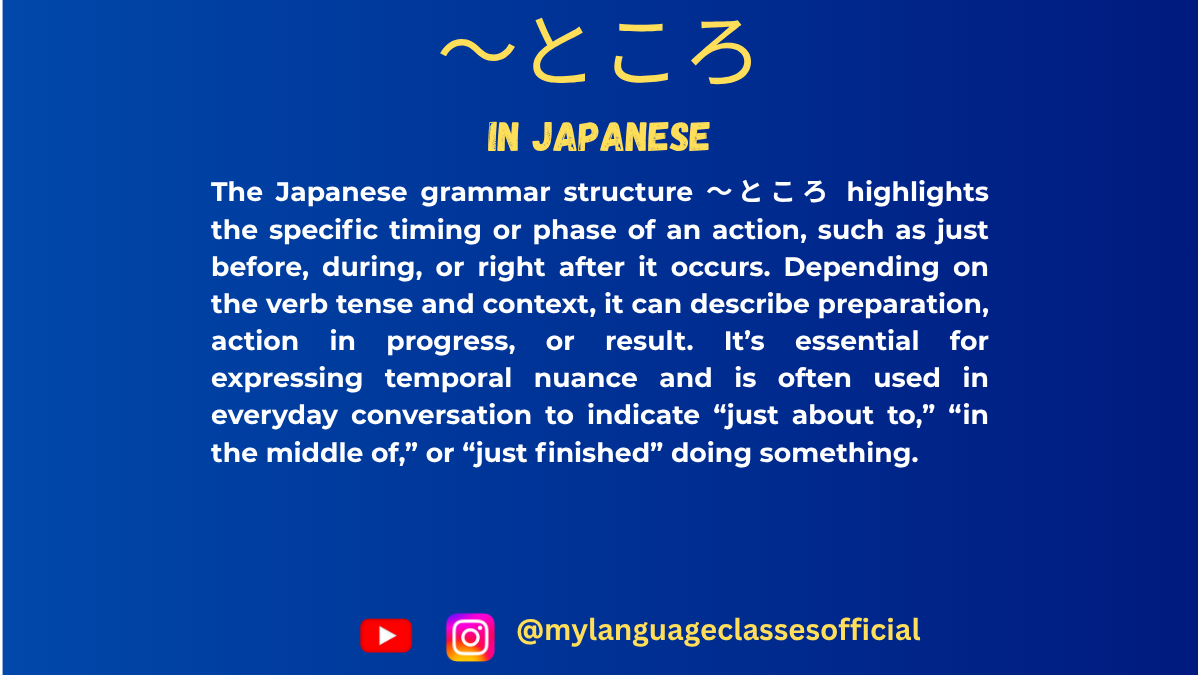
How to Use 〜ところ in Japanese | My Language Classes
Using 〜ところ Form in Japanese
The 〜ところ form is a crucial grammatical structure in Japanese that expresses different stages of an action. It helps indicate whether an action is about to happen, is in progress, or has just been completed. This blog post will cover the formation of 〜ところ for all three verb groups, its various uses, and provide example sentences, things to keep in mind, exercises, and a conclusion.
Formation of 〜ところ Form
Group 1 (Ichidan Verbs)
For ichidan (一段) verbs, remove る from the dictionary form and add the appropriate auxiliary:
- Before the action: 〜るところ
- During the action: 〜ているところ
- After the action: 〜たところ
Example:
- 食べる (taberu – to eat)
- Before: 食べるところ (taberu tokoro)
- During: 食べているところ (tabete iru tokoro)
- After: 食べたところ (tabeta tokoro)
Group 2 (Godan Verbs)
For godan (五段) verbs, use the same rules as ichidan verbs but conjugate accordingly:
- Before the action: Dictionary form + ところ
- During the action: て-form + いるところ
- After the action: た-form + ところ
Example:
- 読む (yomu – to read)
- Before: 読むところ (yomu tokoro)
- During: 読んでいるところ (yonde iru tokoro)
- After: 読んだところ (yonda tokoro)
Group 3 (Irregular Verbs)
For irregular verbs like する and くる:
- する (suru – to do)
- Before: するところ (suru tokoro)
- During: しているところ (shite iru tokoro)
- After: したところ (shita tokoro)
- くる (kuru – to come)
- Before: くるところ (kuru tokoro)
- During: きているところ (kite iru tokoro)
- After: きたところ (kita tokoro)
Usage of 〜ところ
Situations where 〜ところ is used:
Situation Form Used Example Right before an action るところ 今から寝るところです。 (I’m just about to sleep.) In the middle of an action ているところ ちょうど宿題をしているところです。 (I am in the middle of doing my homework.) Just after an action たところ ちょうどご飯を食べたところです。 (I just finished eating.) To indicate an important moment る・ている・たところ 試験を受けるところだった。(I was just about to take the exam.) When explaining a sequence of events たところ 先生に聞いたところ、すぐに答えがわかった。(When I asked the teacher, I immediately understood the answer.)
Example Sentences
- 電車が出発するところです。
Densha ga shuppatsu suru tokoro desu.
(The train is about to depart.) - 彼は今、電話しているところです。
Kare wa ima, denwa shite iru tokoro desu.
(He is on the phone right now.) - ちょうど昼ご飯を食べたところです。
Choudo hirugohan o tabeta tokoro desu.
(I just finished eating lunch.) - 飛行機が今にも飛ぶところです。
Hikouki ga ima ni mo tobu tokoro desu.
(The airplane is just about to take off.) - 友達と話しているところでした。
Tomodachi to hanashite iru tokoro deshita.
(I was in the middle of talking with my friend.) - 彼に聞いたところ、すぐに答えてくれました。
Kare ni kiita tokoro, sugu ni kotaete kuremashita.
(When I asked him, he answered immediately.) - ちょうど今、家を出るところです。
Choudo ima, ie o deru tokoro desu.
(I am just about to leave home.) - 映画を見ているところです。
Eiga o mite iru tokoro desu.
(I am in the middle of watching a movie.) - 買い物が終わったところです。
Kaimono ga owatta tokoro desu.
(I just finished shopping.) - 勉強するところだったのに、友達が来ました。
Benkyou suru tokoro datta noni, tomodachi ga kimashita.
(I was about to study, but my friend came.)
Things to Keep in Mind
- 〜ところ emphasizes timing rather than the state of an action.
- Be careful not to confuse たところ with たばかり; たところ emphasizes immediate completion.
- ているところ is often used to explain ongoing actions.
- This form is frequently used with words like ちょうど (exactly, just), 今 (now), まさに (precisely).
Fill in the Blanks
- ちょうど今、映画を____ところです。
- 飛行機が____ところでした。
- 彼は電話を____ところです。
- 今、家を____ところです。
- 私は宿題を____ところだった。
- 友達が来たので、ちょうど出かける____だった。
- 先生に聞いた____、すぐに理解しました。
- 彼はまだ寝る____ではありません。
- ちょうどレポートを____ところでした。
- 仕事が終わった____です。
Answers
- 見ている
- 飛ぶ
- している
- 出る
- する
- ところ
- ところ
- ところ
- 書く
- ところ
Conclusion
The 〜ところ form is an essential grammar point that helps clarify the timing of an action. Whether something is about to happen, currently happening, or has just happened, understanding how to use 〜ところ correctly will significantly improve your Japanese fluency. Keep practicing, and soon this structure will become second nature in your conversations!
If you enjoyed this lesson, be sure to check out more posts like this on my blog at My Language Classes. Don’t forget to subscribe my YouTube channel and follow me on Instagram for the latest language learning tips and lessons. Leave a comment below to share your thoughts, or ask any questions you have about nouns.
Happy learning! 😊
-
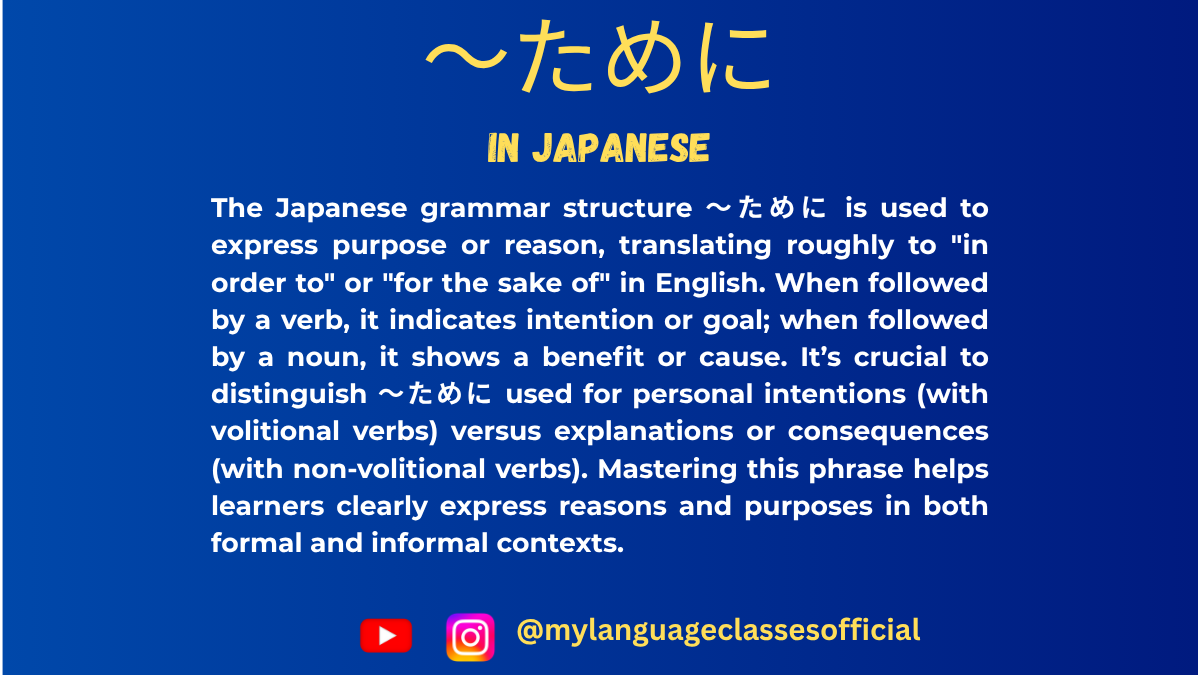
Using 〜ために in Japanese | My Language Classes
Understanding 〜ために in Japanese
In Japanese, “〜ために” (tame ni) is a highly versatile grammatical structure used to indicate purpose, reason, or benefit. Understanding its different meanings and contexts is crucial for mastering the Japanese language.
This article will explain all the possible uses of “ために” along with example sentences and a list of situations where it is commonly used.
**1. Expressing Purpose (目的)
The most common use of “ために” is to express purpose or intention. In this case, it is used with dictionary form verbs or nouns.**
Structure:
- Verb (dictionary form) + ために
- Noun + の + ために
Examples:
- 体重を減らすために歩いています。 (I walk in order to lose weight.)
- 簡単な日本語を勉強するためにこのアプリを使う。 (I use this app to study simple Japanese.)
- 健康のために毎日ヨガをしています。 (For my health, I do yoga every day.)
Note:
- “ために” is used for intentional actions performed by someone with a goal in mind.
2. Expressing Reason or Cause (原因)
“ために” can also be used to express a reason or cause for a particular event, similar to “because of” in English.
Structure:
- Verb (plain past form) + ために
- Noun + の + ために
Examples:
- 天気が悪かったためにゲームが中止された。 (Because of bad weather, the game was canceled.)
- 病気のために休んだ。 (I took a break because of illness.)
- 仕事が大変だったためにとても疲れています。 (Because work was difficult, I am very tired.)
Note:
- In this case, the outcome is not controlled by the speaker and is often negative.
3. Expressing Benefit or Effect (利益)
Another meaning of “ために” is to indicate the benefit or positive effect of something.
Structure:
- Noun + の + ために
Examples:
- 子供のために私たちは最良の教育を提供したい。 (For the benefit of children, we want to provide the best education.)
- 世界のために安全な環境を作りましょう。 (For the benefit of the world, let’s create a safe environment.)
Note:
- This use of “ために” is often found in formal speech, policies, and slogans.
4. “ために” vs. “ように” (Comparison)
Both “ために” and “ように” express purpose, but they have different uses:
Phrase Used with Meaning ために Dictionary-form verbs (intentional) Purpose (the subject can control the action) ように Potential-form verbs or non-intentional actions Purpose (the subject cannot directly control the action) Examples:
- ために: 体重を減らすために歩いています。 (I walk in order to lose weight.)
- ように: 日本語を話せるように勉強している。 (I study so that I can speak Japanese.)
Key difference: “ために” is used when the subject can control the outcome, while “ように” is used for situations where the outcome depends on ability or an external factor.
Situations Where 〜ために is Used
Situation Example Expressing Purpose 旅行するためにお金を貯めています。 Expressing Reason 天気が悪かったためにコンサートが中止された。 Expressing Benefit 社会のために活動しています。
Conclusion
The structure “ために” is an essential part of Japanese grammar, used to express purpose, reason, and benefit. Mastering its different uses will greatly improve your ability to form complex and meaningful sentences in Japanese.
Understanding the differences between “ために” and similar expressions like “ように” will help you sound more natural in Japanese conversations. Keep practicing and using “ために” in different contexts!
If you enjoyed this lesson, be sure to check out more posts like this on my blog at My Language Classes. Don’t forget to subscribe my YouTube channel and follow me on Instagram for the latest language learning tips and lessons. Leave a comment below to share your thoughts, or ask any questions you have about nouns.
Happy learning! 😊
-
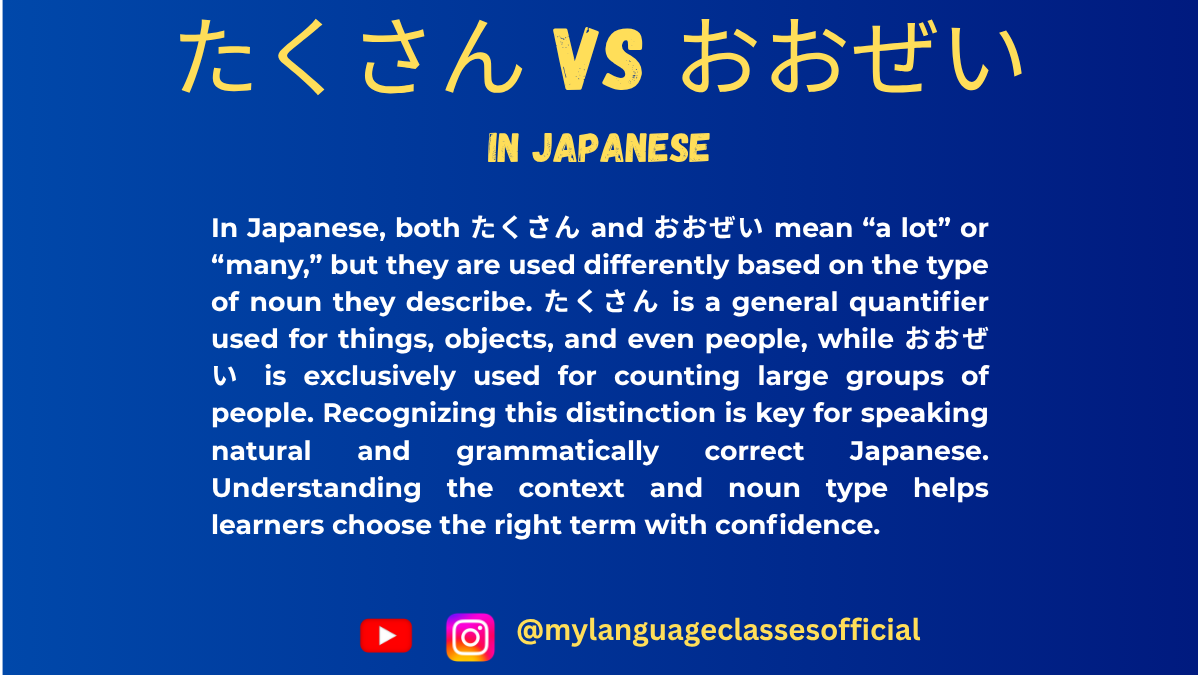
たくさん vs おおぜい: the Differences in Japanese | My Language Classes
たくさん vs おおぜい
When learning Japanese, many students come across the words たくさん (takusan) and おおぜい (oozei), both of which mean “a lot” or “many.” However, they are not interchangeable in every situation. Understanding their nuances will help you use them naturally in conversations and writing.
1. Basic Meaning and Key Difference
- たくさん (takusan): Means “a lot,” “many,” or “plenty” and can be used for both countable and uncountable nouns.
- おおぜい (oozei): Specifically refers to “a large number of people” and is used only for people.
2. Usage of たくさん (takusan)
A. With Countable and Uncountable Nouns
- たくさん can be used with both things that can be counted (books, apples, pens) and things that cannot be counted (water, happiness, love).
Examples:
- 机の上に本がたくさんあります。
Tsukue no ue ni hon ga takusan arimasu.
→ There are many books on the desk. - 今日は仕事がたくさんあります。
Kyou wa shigoto ga takusan arimasu.
→ I have a lot of work today. - 私はお金をたくさん持っています。
Watashi wa okane o takusan motteimasu.
→ I have a lot of money.
B. Placement of たくさん in a Sentence
- Before the noun (less common in daily speech):
- たくさんの友達がいます。(Takusan no tomodachi ga imasu.)
→ I have many friends.
- たくさんの友達がいます。(Takusan no tomodachi ga imasu.)
- After the noun (more natural):
- 友達がたくさんいます。(Tomodachi ga takusan imasu.)
→ I have many friends.
- 友達がたくさんいます。(Tomodachi ga takusan imasu.)
- With verbs (indicating an action done in large amounts):
- ご飯をたくさん食べました。(Gohan o takusan tabemashita.)
→ I ate a lot of food.
- ご飯をたくさん食べました。(Gohan o takusan tabemashita.)
3. Usage of おおぜい (oozei)
A. Used Only for a Large Number of People
- おおぜい is exclusively used when talking about a crowd, a large number of people, or a gathering.
Examples:
- コンサートにはおおぜいの人が来ました。
Konsaato ni wa oozei no hito ga kimashita.
→ A large number of people came to the concert. - その町には観光客がおおぜいいました。
Sono machi ni wa kankoukyaku ga oozei imashita.
→ There were many tourists in that town. - おおぜいの学生が試験を受けました。
Oozei no gakusei ga shiken o ukemashita.
→ A lot of students took the exam.
B. Placement of おおぜい in a Sentence
- Before the noun:
- おおぜいの人が集まりました。(Oozei no hito ga atsumarimashita.)
→ Many people gathered.
- おおぜいの人が集まりました。(Oozei no hito ga atsumarimashita.)
- After the noun (less common but acceptable):
- 人がおおぜい集まりました。(Hito ga oozei atsumarimashita.)
→ A lot of people gathered.
- 人がおおぜい集まりました。(Hito ga oozei atsumarimashita.)
4. Situations Where たくさん and おおぜい Are Used
Situation Use たくさん Use おおぜい Talking about a large number of objects (books, apples, cars, etc.) ✅ Yes ❌ No Talking about a large quantity of uncountable things (water, love, money, etc.) ✅ Yes ❌ No Talking about a large number of people ✅ Yes ✅ Yes Talking about a crowd or a gathering of people ❌ No ✅ Yes Used with verbs like “eat” or “buy” (大量に食べる, 大量に買う) ✅ Yes ❌ No Used before a noun as an adjective ✅ Yes (たくさんの) ✅ Yes (おおぜいの) Used after a noun naturally ✅ Yes ✅ Yes (but limited to people) 5. Summary of Key Differences
Word Meaning Used for Example Sentence たくさん (takusan) A lot, many, plenty Both people and things 友達がたくさんいます。 (I have many friends.) おおぜい (oozei) A large number of people, crowd Only people コンサートにおおぜいの人が来ました。 (A large number of people came to the concert.) 6. Common Mistakes to Avoid
- ❌ おおぜいの本があります。 (Oozei no hon ga arimasu.) → Incorrect, because おおぜい is only for people.
- ✅ たくさんの本があります。 (Takusan no hon ga arimasu.) → Correct, because たくさん can be used for books.
- ❌ たくさんの人がいた。 (Takusan no hito ga ita.) → Grammatically correct, but おおぜいの人がいた sounds more natural when referring to a crowd.
7. Conclusion
Both たくさん and おおぜい mean “many,” but their usage differs depending on what you are referring to. たくさん is more versatile as it can be used with both things and people, while おおぜい is exclusively used for a large number of people. By keeping these differences in mind, you can use these words accurately and naturally in your Japanese conversations!
By mastering these distinctions, you can enhance your fluency and express yourself more precisely in Japanese. Keep practicing, and soon using たくさん and おおぜい correctly will become second nature! Happy learning! 😊
If you enjoyed this lesson, be sure to check out more posts like this on my blog at My Language Classes. Don’t forget to subscribe my YouTube channel and follow me on Instagram for the latest language learning tips and lessons. Leave a comment below to share your thoughts, or ask any questions you have about nouns.
Happy learning! 😊
-
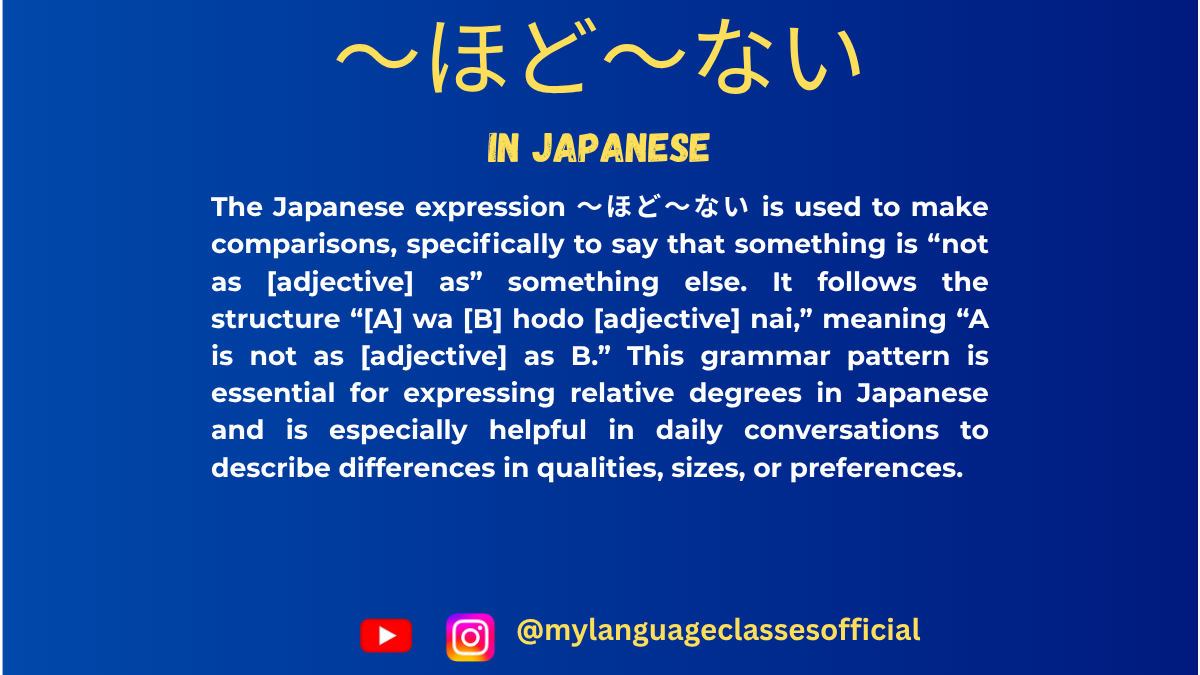
Using 〜ほど〜ない in Japanese | My Language Classes
Understanding 〜ほど〜ない in Japanese
The Japanese grammar pattern 「〜ほど〜ない」 is commonly used for making comparisons and expressing degree or extent. It implies that something is “not as much as” something else. This phrase is often translated as “not as… as…” in English.
Basic Structure of 〜ほど〜ない
The structure of this grammar pattern is as follows:
Noun + ほど + Adjective (ない-form)
or
Verb (dictionary form) + ほど + Adjective (ない-form)
General Meaning
「A ほど B ない」 means that B is not as A.
- A is the standard of comparison.
- B is the thing being compared.
Examples:
- この町は東京ほど賑やかではない。
(Kono machi wa Tōkyō hodo nigiyaka de wa nai.)
→ This town is not as lively as Tokyo. - 彼は私ほど速く走れない。
(Kare wa watashi hodo hayaku hashirenai.)
→ He cannot run as fast as I do. - この問題は思ったほど難しくない。
(Kono mondai wa omotta hodo muzukashiku nai.)
→ This problem is not as difficult as I thought.
Situations Where 〜ほど〜ない is Used
1. Comparing Extent or Degree
- Used when two things are compared, but the second one (B) has less intensity than the first (A).
Example:
北海道の冬は東京の冬ほど寒くない。
(Hokkaidō no fuyu wa Tōkyō no fuyu hodo samuku nai.)
→ Hokkaido’s winter is not as cold as Tokyo’s winter.2. Expressing Subjective Opinions
- Often used to express personal opinions about differences in perception.
Example:
数学は国語ほど難しくないと思います。
(Sūgaku wa kokugo hodo muzukashiku nai to omoimasu.)
→ I think math is not as difficult as Japanese.3. Negative Comparison in Abilities or Characteristics
- Used when comparing someone’s ability or characteristics with another’s.
Example:
彼の英語は先生ほど上手ではない。
(Kare no eigo wa sensei hodo jōzu de wa nai.)
→ His English is not as good as the teacher’s.4. Comparing Expectations vs Reality
- Used when expectations were high, but the actual situation is not as expected.
Example:
この映画は評判ほど面白くない。
(Kono eiga wa hyōban hodo omoshiroku nai.)
→ This movie is not as interesting as its reputation suggests.5. Comparing Feelings and Emotions
- Used when talking about feelings that are not as strong as expected.
Example:
彼は私が思ったほど優しくない。
(Kare wa watashi ga omotta hodo yasashiku nai.)
→ He is not as kind as I thought.6. Comparing Physical Condition or Health
- Used to compare health conditions or physical states.
Example:
風邪は思ったほどひどくない。
(Kaze wa omotta hodo hidoku nai.)
→ The cold is not as bad as I thought.7. Comparing Amount or Frequency
- Used when comparing quantity or frequency of actions.
Example:
今日は昨日ほど忙しくない。
(Kyō wa kinō hodo isogashiku nai.)
→ Today is not as busy as yesterday.8. Comparing Importance or Necessity
- Used when comparing levels of importance or necessity.
Example:
宿題はテストほど大事ではない。
(Shukudai wa tesuto hodo daiji de wa nai.)
→ Homework is not as important as tests.9. Comparing Strength of Desire or Preference
- Used to compare desires, preferences, or interests.
Example:
私は映画を見るのが好きですが、本を読むほど好きではない。
(Watashi wa eiga o miru no ga suki desu ga, hon o yomu hodo suki de wa nai.)
→ I like watching movies, but not as much as reading books.
Key Points to Remember About 〜ほど〜ない
- It is used for making comparisons where the second element has less intensity.
- It is often used to express subjective opinions.
- It is used to compare expectations vs reality.
- It can be used in various contexts: ability, frequency, amount, physical conditions, and emotions.
- It follows a simple pattern: “A ほど B ない”, where A is the standard, and B is the thing being compared.
Conclusion
The 「〜ほど〜ない」 grammar pattern is an essential part of Japanese when making negative comparisons. Mastering it will help you express your opinions, compare things effectively, and sound more natural in conversations. Make sure to practice using this structure in daily life to reinforce your understanding!
If you enjoyed this lesson, be sure to check out more posts like this on my blog at My Language Classes. Don’t forget to subscribe my YouTube channel and follow me on Instagram for the latest language learning tips and lessons. Leave a comment below to share your thoughts, or ask any questions you have about nouns.
Happy learning! 😊
-
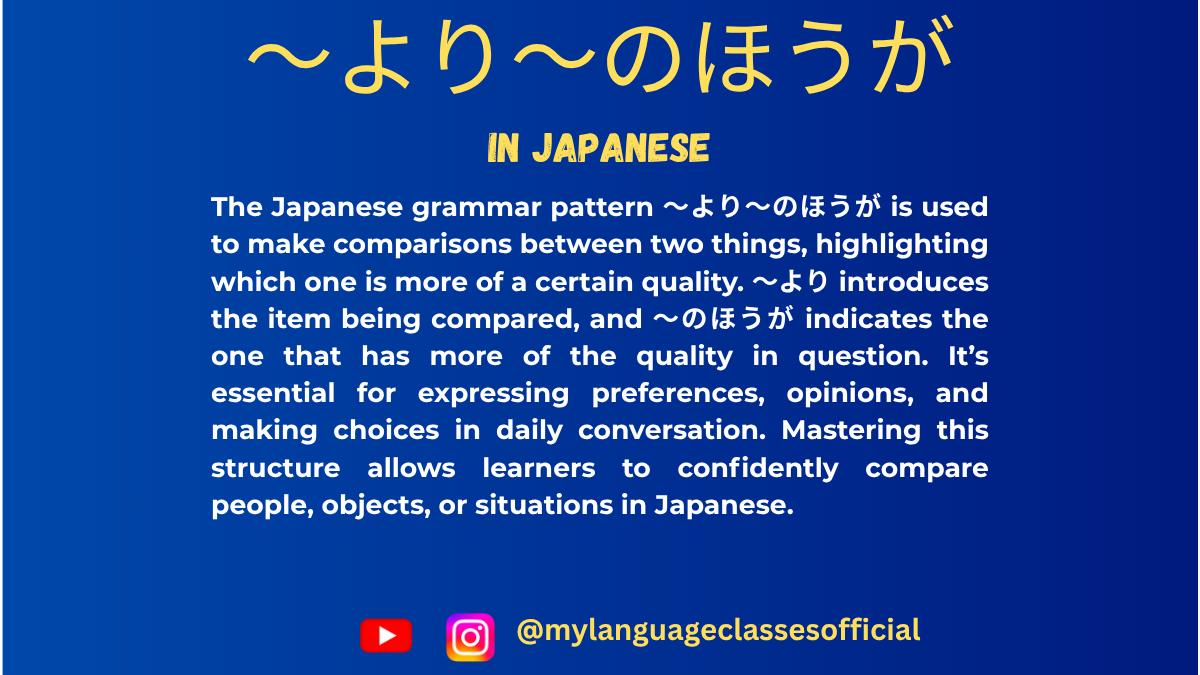
Understanding 〜より〜のほうが in Japanese | My Language Classes
Understanding 〜より〜のほうが
The construction 〜より〜のほうが is an essential tool in Japanese for making comparisons. It translates to “X is more than Y” or “X is better/more suitable than Y” and is widely used in everyday conversations, formal contexts, and written communication. This blog post dives into its meaning, usage, and various scenarios.
Structure of 〜より〜のほうが
The pattern is straightforward:
- Yより Xのほうが adjective/descriptive phrase.
- Yより: Indicates the thing being compared (Y).
- Xのほうが: Highlights the preferred or superior item (X).
Example:
- 犬より猫のほうが好きです。
(I like cats more than dogs.)
Core Uses of 〜より〜のほうが
- Preference
When expressing a preference between two items, activities, or options:- 旅行より勉強のほうが楽しいです。
(Studying is more fun than traveling.)
- 旅行より勉強のほうが楽しいです。
- Quantitative Comparisons
Highlighting differences in measurable qualities like size, speed, or price:- バスより電車のほうが早いです。
(Trains are faster than buses.) - このレストランよりあのレストランのほうが安いです。
(That restaurant is cheaper than this one.)
- バスより電車のほうが早いです。
- Capabilities
Used to compare abilities or skills:- 英語より日本語のほうが得意です。
(I’m better at Japanese than English.)
- 英語より日本語のほうが得意です。
- Frequency or Intensity
Comparing how often or how strongly something occurs:- 冬より夏のほうが好きです。
(I like summer more than winter.)
- 冬より夏のほうが好きです。
- Hypotheticals
For discussing hypothetical preferences or outcomes:- 映画館より家で映画を見たほうがいいです。
(Watching a movie at home is better than going to the cinema.)
- 映画館より家で映画を見たほうがいいです。
- Suitability
Indicating one option is more suitable for a specific purpose:- この仕事には男性より女性のほうが適しています。
(For this job, women are more suitable than men.)
- この仕事には男性より女性のほうが適しています。
Situations Where 〜より〜のほうが is Used
- Daily Conversations
- Comparing food, hobbies, weather, or locations:
- 寿司よりラーメンのほうがおいしいと思います。
(I think ramen is tastier than sushi.)
- 寿司よりラーメンのほうがおいしいと思います。
- Comparing food, hobbies, weather, or locations:
- Business and Professional Settings
- Discussing product qualities or work efficiency:
- この方法よりその方法のほうが効率的です。
(That method is more efficient than this one.)
- この方法よりその方法のほうが効率的です。
- Discussing product qualities or work efficiency:
- Travel and Leisure
- Comparing destinations, travel modes, or activities:
- 海外旅行より国内旅行のほうが安心です。
(Domestic travel is safer than international travel.)
- 海外旅行より国内旅行のほうが安心です。
- Comparing destinations, travel modes, or activities:
- Education and Learning
- Comparing subjects or teaching methods:
- 自習より先生に教えてもらうほうがいいです。
(Being taught by a teacher is better than self-study.)
- 自習より先生に教えてもらうほうがいいです。
- Comparing subjects or teaching methods:
- Relationships and Social Scenarios
- Evaluating people or interpersonal qualities:
- 彼より彼女のほうが優しいです。
(She is kinder than him.)
- 彼より彼女のほうが優しいです。
- Evaluating people or interpersonal qualities:
Key Notes
- Implied Context:
In conversational Japanese, the context often allows for the omission of repetitive elements:- 映画よりドラマのほうが好きです。(I like dramas more than movies.)
Can be shortened to:- ドラマのほうが好きです。 (I like dramas more.)
- 映画よりドラマのほうが好きです。(I like dramas more than movies.)
- Neutrality:
The phrase is neutral and doesn’t carry judgmental connotations, making it versatile for all scenarios. - Politeness Levels:
Depending on the situation, you can adjust politeness levels:- Casual: 〜より〜のほうがいい。
- Polite: 〜より〜のほうがいいです。
- Formal: 〜より〜のほうが適切です。
Practice Examples
- 自転車より車のほうが速いです。
(Cars are faster than bicycles.) - テレビを見るより本を読むほうがいいです。
(Reading books is better than watching TV.) - 東京より大阪のほうが住みやすいと思います。
(I think Osaka is easier to live in than Tokyo.)
By mastering 〜より〜のほうが, you can convey nuanced preferences and comparisons effectively. Practice using it in different contexts to build fluency!
What comparisons will you try making today? Let me know in the comments!
If you enjoyed this lesson, be sure to check out more posts like this on my blog at My Language Classes. Don’t forget to subscribe my YouTube channel and follow me on Instagram for the latest language learning tips and lessons. Leave a comment below to share your thoughts, or ask any questions you have about nouns.
Happy learning! 😊
- Yより Xのほうが adjective/descriptive phrase.
-
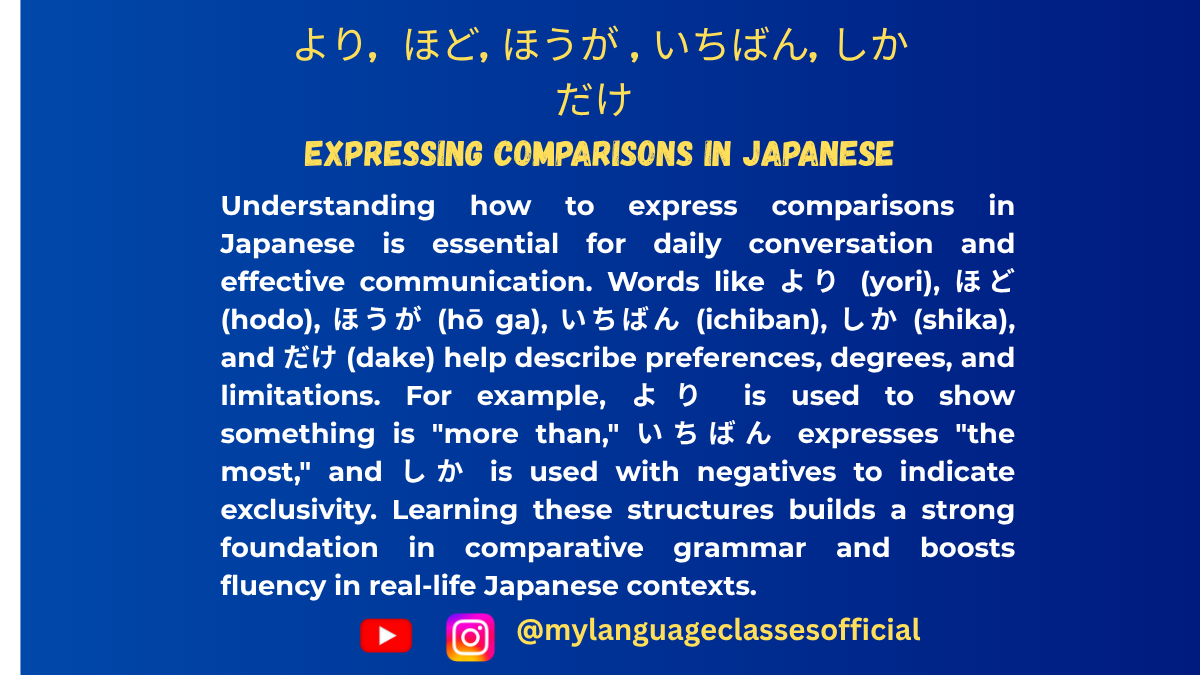
Mastering Comparisons in Japanese より, ほど, ほうが, いちばん, しか, and だけ | My Language Classes
Expressing Comparisons in Japanese より, ほど, ほうが, いちばん, しか, and だけ
When learning Japanese, one of the most important concepts is mastering the art of comparisons. Whether you’re talking about how something is “better” or “more” than something else, or simply stating your preference, knowing how to compare effectively helps you express yourself clearly and confidently. In this post, we’ll cover some of the most essential comparison structures in Japanese: より (more than), ほど (more than / to the extent of), ほうが (preference), いちばん (the most), and dive into important distinctions such as より vs ほど and だけ vs しか.
1. より (More Than)
The particle より is used when comparing two items, indicating that one is more than the other. It’s the most straightforward way to show superiority or difference between two things.
Example:
- この映画はあの映画より面白いです。
Kono eiga wa ano eiga yori omoshiroi desu.
This movie is more interesting than that movie.
Here, より is used to compare the two movies, with the first one being more interesting than the second.
2. ほど (More Than / To the Extent of)
ほど is used to express a comparison where something is “more than” another thing, but with a focus on degree or extent. It’s often used when talking about how much more of something there is, especially in terms of actions or abilities.
Example:
- 彼は私ほど速く走れません。
Kare wa watashi hodo hayaku hashiremasen.
He can’t run as fast as I can.
Here, ほど is used to emphasize the difference in the degree of speed. It’s not just “more than” in quantity, but more in terms of ability or extent.
3. より vs ほど (Key Difference)
While both より and ほど can be translated as “more than,” the distinction lies in their nuance:
- より is used for simple comparisons, where one thing is greater or superior than another in a more straightforward sense.
- ほど is used when discussing the degree or extent of a comparison, often involving abilities, qualities, or actions. It can also suggest “to the extent that” or “as much as.”
Example:
- 彼は私より背が高いです。
Kare wa watashi yori se ga takai desu.
He is taller than I am.
(Simple comparison) - 彼は私ほど速く走れません。
Kare wa watashi hodo hayaku hashiremasen.
He can’t run as fast as I can.
(Degree of ability comparison)
4. ほうが (Preference)
The structure ほうが is used to express preference between two things, indicating that one thing is favored over the other.
Example:
- 日本の映画はアメリカの映画より面白いほうが好きです。
Nihon no eiga wa Amerika no eiga yori omoshiroi hō ga suki desu.
I prefer Japanese movies over American movies because they are more interesting.
In this sentence, ほうが emphasizes the preference for Japanese movies compared to American movies.
5. いちばん (The Most)
いちばん is used to indicate the highest degree of something, meaning “the most” or “the best.” It’s used when something stands out as the most in a particular category.
Example:
- 彼女はクラスでいちばんかわいいです。
Kanojo wa kurasu de ichiban kawaii desu.
She is the most beautiful in the class.
Here, いちばん is used to express that she is the top or number one in terms of beauty.
6. だけ (Only) vs しか (Only, but Negative)
Another pair worth noting in comparisons is だけ and しか. Both can be translated as “only,” but the way they are used is quite different.
- だけ is used to indicate a positive statement or simple limitation.Example:
- このレストランには寿司だけがあります。
Kono resutoran ni wa sushi dake ga arimasu.
This restaurant only has sushi.
- このレストランには寿司だけがあります。
- しか is used with a negative verb, indicating “only” but with the sense that there is nothing more than that (often implying something less than expected).Example:
- このレストランには寿司しかありません。
Kono resutoran ni wa sushi shika arimasen.
This restaurant only has sushi (and nothing else).
- このレストランには寿司しかありません。
Notice that with しか, a negative verb is required, while with だけ, the statement can be positive.
Tips for Mastering Comparisons
- Understand the Context: Pay attention to whether you’re making a straightforward comparison or discussing degrees of difference. This will help you choose between より and ほど.
- Practice with Real-Life Examples: Try comparing things you see around you. For example, compare two foods, two movies, or two places. This helps you internalize comparison structures.
- Use ほうが for Preferences: If you’re ever unsure about how to express a preference, use ほうが. It’s a simple way to show that you favor one thing over another.
- Avoid Overcomplicating Things: Don’t worry about using every comparison structure at once. Focus on mastering one at a time—start with より and いちばん, then gradually incorporate ほど and ほうが into your conversations.
- Listen to Native Speakers: Pay attention to how native speakers make comparisons. Listening to their natural flow will help you understand which structure to use in various situations.
Final Thoughts: Mastering Comparisons for Fluent Communication
Mastering comparisons in Japanese is a crucial step toward fluency. By understanding how to use より (more than), ほど (more than / to the extent of), ほうが (preference), and いちばん (the most), you’ll be able to express differences, preferences, and extremes with precision and confidence.
Remember that the key to becoming proficient in any aspect of a language is practice. The more you engage with these comparison structures in your speaking and writing, the more natural they will feel.
So, keep practicing, stay curious, and challenge yourself to use comparisons in your everyday conversations. With continued effort and attention to detail, you’ll be able to navigate the nuances of Japanese comparisons and speak like a native speaker in no time. Happy learning!
If you enjoyed this lesson, be sure to check out more posts like this on my blog at My Language Classes. Don’t forget to subscribe my YouTube channel and follow me on Instagram for the latest language learning tips and lessons. Leave a comment below to share your thoughts, or ask any questions you have about nouns.
Happy learning! 😊
- この映画はあの映画より面白いです。

